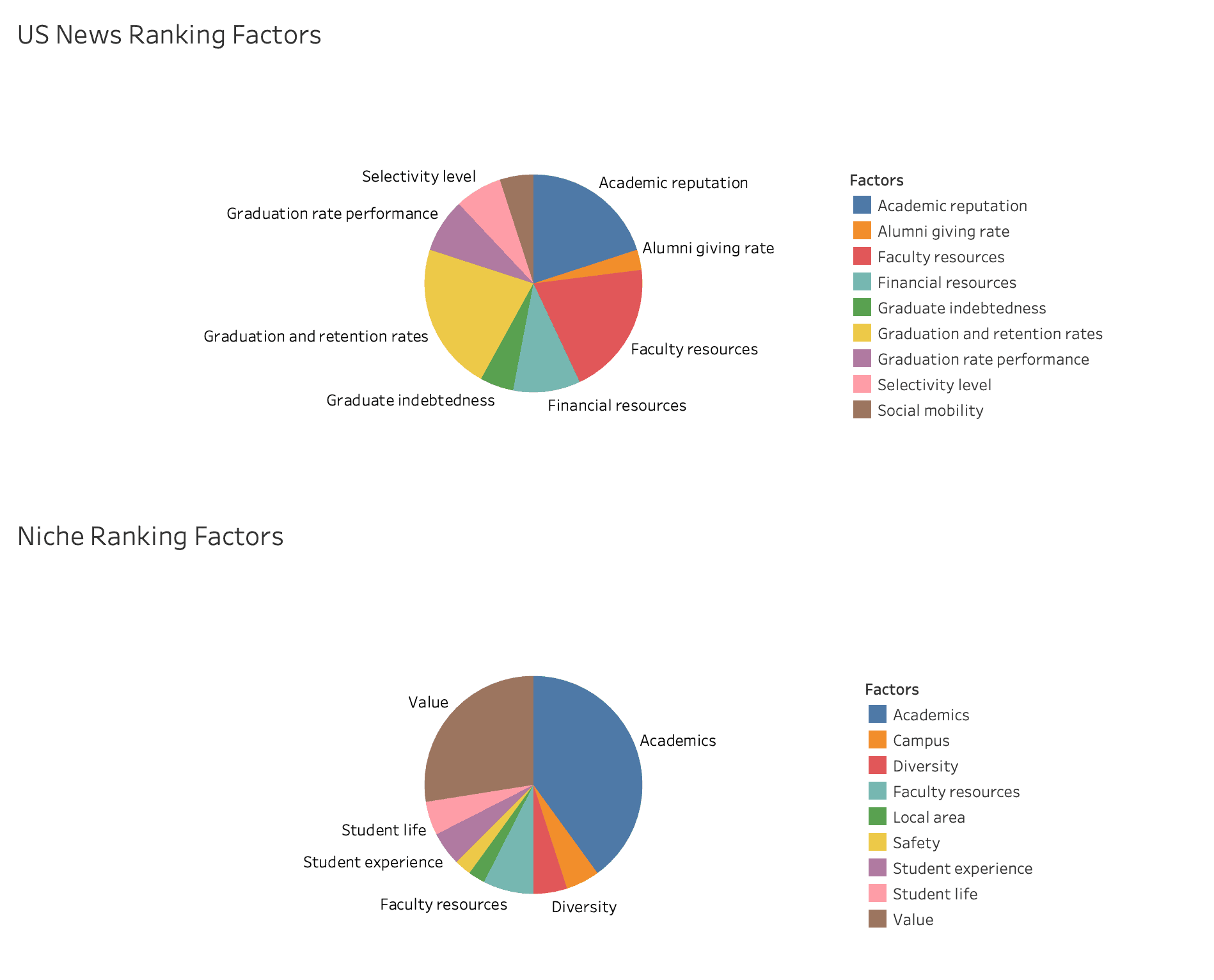Niche vs. US News: A Head-to-Head Comparison of College Rankings
Two of the most popular college ranking sites out there are Niche and US News.
It cannot be denied that US News is the more popular ranker of the two. After all, it debuted its list in 1983, which paved the way for other college ranking sites, including Niche.
Niche came into being in 2002. Even though it’s not as well-known as US News, the Pittsburgh-based college ranking site has its following.
As a matter of fact, more than 50 million people used Niche in the last year. Making the college ranker different from US News is the fact that several of the metrics it uses are derived from student surveys.
Wondering which between Niche and US News you should use as a guide? Read on.
In this post, I will let you in on the different ranking factors used by both college ranking sites as well as how they obtain information used in the college ranking process.
This way, you can have a much better idea of which of these college rankers can help you better in determining which institutions you should add to your college list.

Niche vs. US News: Difference in Methodology
Niche and US News use different factors when ranking institutions of higher education. Similarly, the different ranking factors the popular college ranking sites use have different weights. Some indicators are shared by Niche and US News in common, while other ranking factors are exclusively used by one.
There are 15 distinct overall college rankings Niche has. On the other hand, US News has 10.
Both college ranking sites have their own metrics in determining which college goes on top and which college goes to the bottom. Naturally, they take into account factors they deem important in ranking colleges.
In the table below, you will come across an assortment of factors Niche and US News use when ranking the country’s best colleges and universities. You will also learn which of the indicators considered by each college ranker possess the most influence on the ranking of institutions.
| RANKING FACTORS | NICHE | US NEWS |
|---|---|---|
| Academics | 40% | 20% |
| Alumni giving rate | 3% | |
| Campus | 5% | |
| Diversity | 5% | |
| Faculty resources | 7.50% | 20% |
| Financial resources | 10% | |
| Graduate indebtedness | 5% | |
| Graduation and retention | 22% | |
| Graduation rate performance | 8% | |
| Local area | 2.50% | |
| Safety | 2.50% | |
| Selectivity level | 7% | |
| Social mobility | 5% | |
| Student experience | 5% | |
| Student life | 5% | |
| Value | 27.50% |
As you can see, while there are a couple of ranking factors shared in common by Niche and US News, numerous other factors are used exclusively by each of the well-known college ranking sites.
The same goes for college ranking sites other than Niche and US — some ranking factors may be shared by several college rankers, while other ranking factors may be unique to some. It’s exactly because of the different factors preferred in their methodologies why college rankings have a subjective reputation.
In order to give you a much better idea, just take a look at the following table, which demonstrates how highly ranked colleges and universities can jump from spot to spot between different college ranking sites.
Note: Best Colleges in America 2023 is by Niche and Best National University 2022 to 2023 is by US News.
| RANKING | BEST COLLEGES IN AMERICA, US NEWS | BEST NATIONAL UNIVERSITY, NICHE |
|---|---|---|
| #1 | Massachusetts Institute of Technology | Princeton University |
| #2 | Stanford University | Massachusetts Institute of Technology |
| #3 | Harvard University | Harvard University |
| #4 | Yale University | Stanford University |
| #5 | Princeton University | Yale University |
| #6 | Rice University | University of Chicago |
| #7 | California Institute of Technology | Johns Hopkins University |
| #8 | Duke University | University of Pennsylvania |
| #9 | Brown University | California Institute of Technology |
| #10 | Dartmouth College | Duke University |
| #11 | University of Pennsylvania | Northwestern University |
| #12 | Columbia University | Dartmouth College |
| #13 | Vanderbilt University | Brown University |
| #14 | Northwestern University | Vanderbilt University |
| #15 | Washington University in St. Louis | Rice University |
| #16 | University of Chicago | Washington University in St. Louis |
| #17 | Georgetown University | Cornell University |
| #18 | Harvey Mudd College | Columbia University |
| #19 | University of Notre Dame | University of Notre Dame |
| #20 | Pomona College | University of California, Berkeley |
While there are a couple of institutions that share the same exact spot between Niche and US News’ rankings (Harvard and Notre Dame), the rest occupy different spots — some have a higher or lower position in the other ranking by a small amount, while others by a substantial amount.
If you would create a college list based purely on one college ranking site’s ranking, then it would look a little or entirely different if you’d base your list on another college ranker, depending on which listing you preferred.
9 Ranking Factors Used by Niche
Niche is guided by nine distinct ranking factors when grading colleges and universities to rank. Each of the factors usually consists of several other indicators, which can come from various sources such as a college’s attendees themselves. Factors with the most weight include academics, value, and faculty.
Let’s take a look at the different indicators Niche employs as well as the different factors under each one and the sources of the data considered in ranking institutions.
1. Academics
When grading an institution’s academics to determine its ranking, Niche takes into account an assortment of factors. When combined, the total score makes up a whopping 40% of a school’s grade.
One of the things considered under the ranking factor academics is the acceptance rate. It goes without saying that the more selective a college is, the higher the score.
Also taken into account is the quality of the professors — the same metric is also employed by Niche in coming up with the Colleges With the Best Professors in America ranking.
Student and alumni surveys about the academics at the school are also components of the academics factor.
2. Campus
In order to determine the grade of a college campus-wise, which has an overall weight of 5%, Niche obtains a couple of pieces of information from different sources.
The quality of campus food is one of them, which is done through surveys. Needless to say, the college ranking site obtains details from the students themselves.
Meanwhile, Niche turns to the US Department of Education (USDE) when it’s time to obtain college-reported information on the average cost of meal plans.
3. Diversity
Earning an undergraduate degree on a campus shared with people from various backgrounds fosters many skills necessary for college and career success. And that is why diversity is a Niche college ranking factor with a 5% weight.
Various things come into play in the determination of a school’s campus diversity.
The ethnic composition of the studentry and the proportion of out-of-state students and international students with in-state attendees are taken into account. Niche also surveys currently enrolled students regarding campus diversity.
4. Faculty resources
Numerous things are taken into account by Niche when determining a college’s grade for faculty resources, which is a ranking factor with a 7.5% weight.
Some include student surveys on professors, the number of awards won by full-time faculty members, and an index of professor salaries against the local median household income.
Even faculty diversity is considered — Niche looks into matters such as faculty racial diversity and faculty gender ratio, details that the college ranking site obtains from the USDE.
5. Local area
Out-of-state and international students that make Niche their go-to college ranking site will be more than glad to learn that also a factor in ranking institutions is the locality, which has a weight of 2.5%.
Some of the things that comprise the local area factor include median rent, access to amenities and local crime rates.
Niche also surveys the current students of a college being ranked in order to have an idea of their opinions and experiences with the area around the campus.
6. Safety
Besides the safety outside of the campus, naturally, Niche also considers on-campus safety, which makes up 2.5% of an institution of higher education’s overall college ranking.
Residence hall date violence and rape rates, alcohol- and drug-related arrests, overall campus crime rate — all of these are looked at by Niche when deciding a college’s ranking.
The college ranker also obtains self-reported campus safety and security by the students, allowing them to give a rating from 1 to 5.
7. Student life
Up to 5% of the grade of a college being ranked by Niche is comprised of student life, which consists of several sub-factors.
They include athletics, campus grade, party scene and student life. It’s also under the student life ranking indicator where Niche evaluates the 6-year graduation rate of an institution.
8. Student experience
Because the student experience factor grade can only come from the students themselves, present and former alike, it’s no wonder that Niche surveys both current attendees and alumni members.
What the popular college ranking site does is instruct the participants to give their overall experience at the school on a scale of 1 to 5.
9. Value
Academics is the ranking factor used by Niche with the most weight (40%). On the other hand, the second-most important factor used in the college ranking’s methodology is value, which has a hefty 27.5% weight.
The average net price, which is the cost after financial aid, and the average return on investment (ROI) on graduates are some of the most substantial considerations under the said factor.
Median earnings one year after graduation and six years after graduation are taken into account, too.
Changes in the earnings between the first and second year of employment are also considered by Niche.
In order to round out the ranking factor value, the college ranking site obtains from the USDE the percentages of graduates employed two years after graduation and six years after graduation.
9 Ranking Factors Used by US News
When ranking the best colleges and universities, US News considers 9 distinct ranking factors. The majority of the said primary factors are composed of different indicators, each one having a different weight. Graduation and retention make up the factor with the most weight, which amounts to 22%.
Below, you will come across the different ranking factors US News takes into account when ranking institutions as well as the various sub-factors, if any, under each one.
1. Graduation and retention
Graduation and retention are a part of the outcomes indicator, which consists of 7 different measures. It’s also the one with the most weight among the said group of metrics (22%).
The average 6-year graduation rate (17.6%) and average first-year student retention rate (4.4%) are factors that make up graduation and retention. It makes perfect sense to include graduation and retention rates when determining a college’s ranking — if more students hang around long enough, then the school must be good.
2. Social mobility
Simply put, social mobility, college ranking-wise, refers to the change in the economic socioeconomic situation of a student who just earned an undergraduate degree.
This ranking factor taken into account by US News consists of Pell Grant graduation rate and Pell Grant graduation rate performance. Both factors have a weight of 2.5% each, making up the 5% weight of social mobility. Generally speaking, US News gives extra credit to institutions with larger proportions of students receiving Pell Grants.
3. Graduate indebtedness
Having a 5% weight, graduate and indebtedness is a US News ranking factor that considers the benefits of being armed with an undergraduate degree and the affordability of going to college to earn it. This particular measure consists of 2 different metrics: graduate indebtedness average (3%) and graduate indebtedness proportion (2%).
In a nutshell, graduate indebtedness is influenced by matters such as federal loans and co-signed loans incorporated into eventual graduates, although excluding undergraduate students who transferred from other colleges.
4. Graduation rate performance
Unlike merely scoring a college based on the number of undergraduate students who graduate within a 6-year period, US News takes into account a number of other things when evaluating a college based on the graduation rate performance factor. They include the number of Pell Grant awardees and students who are first in the family to go to college.
5. Faculty resources
Carrying a weight of 20%, thus making it one of the ranking factors used by US News with the most influence on the ranking of an institution, faculty sources is a metric that has something to do with faculty-related matters, including the salary of faculty members, student-to-faculty ratio and class size.
Under faculty resources, class size is considered by US News as having the most weight (8%). The general consensus is that the smaller the class size, the better the learning experience for students.
Class size, in terms of weight, is followed by faculty salaries (7%).
The remaining factors making up faculty resources are the following: faculty members with terminal degrees (3%), student-to-faculty ratio (1%) and proportion of full-time faculty members (1%).
6. Academic reputation
According to US News, academic reputation is a college ranking factor whose various elements cannot be easily obtained on the internet.
And that is why the popular college ranker asks top academics such as deans and presidents to rate the academic quality of peer institutions that they are familiar with.
In rating peer institutions, academics give a rating that ranges from 1 (marginal) to 5 (distinguished).
US News takes the average of ratings worth 2 academic years. In 2022, the college ranking site sent questionnaires to more than 4,800 academics for it to be able to determine a school’s academic reputation, which has a 20% weight.
7. Financial resources
How much a college can spend on each student indicates its ability to provide various programs and services, US News says.
The ranking factor financial resources, which has a weight of 10%, measures an institution’s financial resources through the average spending per attendee on things like student services, instruction and research.
Just like academic reputation, the score of a school’s financial resources is determined by getting the average of scores obtained in a span of 2 years.
8. Selectivity level
Needless to say, the higher the selectivity level, the higher the score. Having a selective admissions policy, according to US News, provides the best possible environment for hardworking students. Similarly, it allows college professors to design more rigorous undergraduate classes.
In order to compute for selectivity level, math and evidence-based reading and writing components of the composite SAT and ACT scores are taken into account, yielding a total weight of 5%.
High school class standing comprises 2% of the selectivity level ranking factor.
Whether graduating in the top 10% of the class or in the top 25% of the class that counts depends on the type of school. In the case of national universities and liberal arts, students that graduated in the top 10% of their high school class are considered.
Combined, the total weight of selectivity level amounts to 7%.
9. Alumni giving
Gifts given by living alumni members to their alma maters, simply put, can speak volumes about the satisfaction of graduates with their college experience.
And it’s exactly due to this why US News includes alumni giving rate, which has a weight of 3%, in the various factors considered when ranking colleges and universities.
So, Which Between Niche and US News is Best for You?
Niche and US News use different factors in ranking colleges. Which of them you should take a look at when comparing schools you wish to add to your college list will depend on what you look for in an institution.
For instance, while Niche uses the same number of primary factors as US News, it has many additional indicators under each one, some of which are not considered by US News.
Things such as athletics, campus food and faculty diversity are all taken into account by Niche, which is good if you find them important.
However, the use of so many factors may also throw you off, which can make building a college list harder.
But what’s so nice about Niche is that many of its indicators are obtained from the opinions and experiences of current and past students alike, thus allowing you to have a much better idea of what it’s like to be a part of the student body of the institution you are considering applying to.
On the other hand, many of the ranking factors utilized by US News are based on peer reviews, which means they come from the opinions and experiences of academics such as deans and presidents.
In addition, while it has the same number of primary ranking factors as Niche, the majority of them consist of only 1 to 2 sub-indicators or none at all.
Because of this, US News college rankings may be more focused, paying special attention to some of the most important considerations among many college-bound teens, such as the quality of academics and retention rate.
But it’s important to keep in mind that US News tends to rank colleges largely based on selectivity level. It also focuses more on institutions of higher education with larger populations.
So, if you are thinking about applying to a less selective small college, chances are that it’s not US News ranked — but it doesn’t necessarily mean that it’s bad.
Read More:
- US News Ranking vs. QS Ranking
- US News vs. Forbes
- 14 Alternatives to US News Rankings
- Washington Monthly vs. US News
- Kiplinger vs. US News
Disclaimer: The views and opinions expressed in this article are those of the authors and do not necessarily represent those of the College Reality Check.





